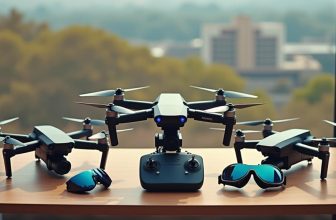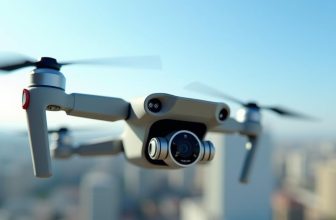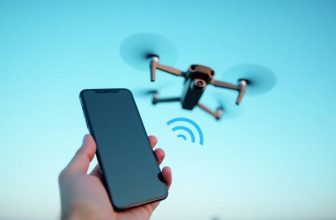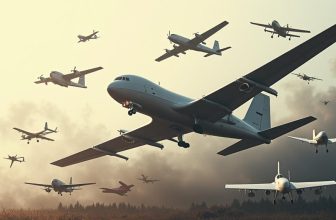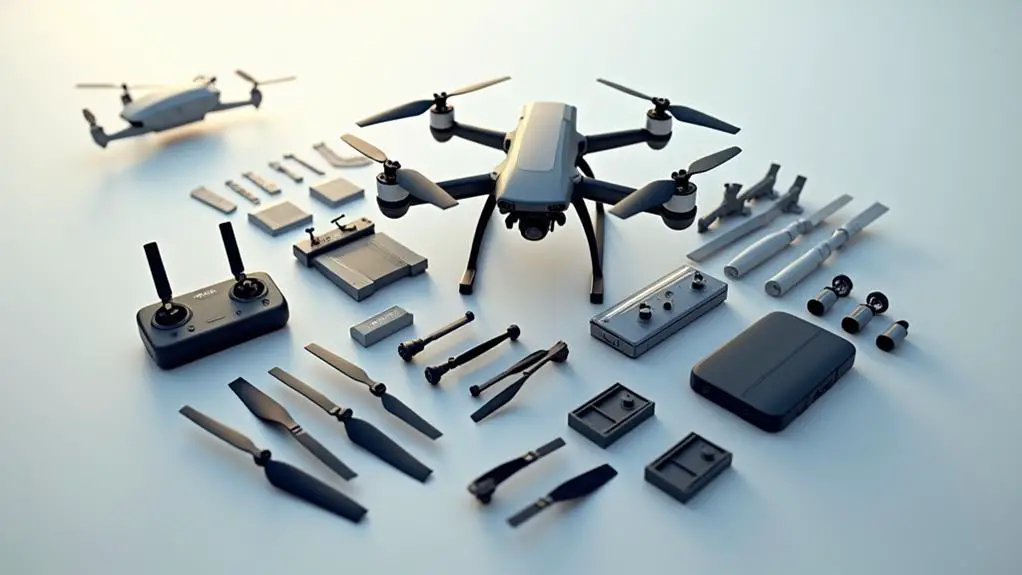
If you’re contemplating investing in a drone, you’re likely wondering what costs to expect beyond the initial purchase price. As you explore your options, you’ll find that drone costs can vary substantially depending on the type of drone you choose and how you plan to use it. Recreational drones can be relatively affordable, while professional-grade or specialized drones can come with a higher price tag. But that’s just the beginning – there are many additional expenses to ponder. What are these expenses, and how can you factor them into your budget to guarantee you get the most out of your drone?
Contents
- 1 Key Takeaways
- 2 Types of Drones Available
- 3 Drone Purchase Price Factors
- 4 Additional Equipment Costs
- 5 Drone Maintenance Expenses
- 6 Accessory and Upgrade Costs
- 7 Drone Registration Fees
- 8 Insurance and Liability Costs
- 9 Operating and Training Expenses
- 10 FAQs: Cost of Drone a Comprehensive Guide
- 11 Conclusion
Key Takeaways
- Drone type and brand significantly impact the purchase price, with recreational drones being more affordable than professional drones.
- Additional equipment and upgrade costs, such as GPS and high-definition cameras, can notably increase the overall price.
- Drone maintenance and operating expenses, like propeller replacement and pilot salaries, can add up over time and should be factored into costs.
- Registration fees, such as those required by the FAA, vary depending on the drone type and usage, with costs ranging from $5 to $150.
- Insurance and liability costs are essential considerations, as they can protect against accidents and damage caused by drone operations.
Types of Drones Available
Considering your budget and intended use, you’ll find a variety of drones on the market.
Drone categories can be broadly classified into three main types: recreational, professional, and industrial. Recreational drones are ideal for casual use and are often more affordable. They typically feature simple designs, are easy to operate, and usually come with basic camera capabilities.
Professional drones, on the other hand, are designed for specific applications such as aerial photography, surveying, and mapping.
These drones often come with advanced camera systems and sensors, allowing for high-quality image and video capture. They’re typically more expensive and require a higher level of expertise to operate.
If you’re looking to capture stunning aerial footage or photos, you’ll want to weigh the options of a drone with a high-quality camera and stabilization system.
Aerial photography drones often feature 4K resolution, wide-angle lenses, and advanced image processing algorithms.
These drones are designed to provide smooth, stable footage, and are ideal for applications such as filmmaking, real estate photography, and construction monitoring.
Drone Purchase Price Factors
When you consider buying a drone, you’ll encounter varying purchase prices that are influenced by drone type variations, such as multi-rotor, fixed-wing, or hybrid models.
The brand and quality of the drone also substantially impact its price, with well-known manufacturers often charging more for their products.
As you evaluate your options, this is crucial to assess how these factors align with your needs and budget.
Drone Type Variations
As you explore into the world of drone purchasing, it becomes clear that the cost of a drone is heavily influenced by its type and intended use.
Drone classification plays a significant role in determining the price, with drones falling into several categories, including recreational, commercial, and military.
For aerial photography, drones equipped with high-resolution cameras and stabilizers are preferred.
These drones typically fall into the commercial category and come with a higher price tag.
Aerial photography drones can range from a few hundred dollars for a basic model to several thousand dollars for a high-end model with advanced features.
In addition to aerial photography, other drone types include racing drones, surveying drones, and inspection drones.
Each type has its unique features and requirements, which affect the price.
Racing drones, for example, are designed for speed and agility, while surveying drones are equipped with advanced sensors and mapping capabilities.
Understanding the specific drone type and its intended use is essential to determine the cost and guarantee you get the right drone for your needs.
Brand and Quality
The drone’s brand and quality are crucial factors in determining its purchase price, directly impacting your overall cost.
When you choose a reputable brand, you’re paying for the quality, durability, and performance of the drone. Luxury brands, such as DJI, Parrot, and Yuneec, offer high-end drones made from premium materials, resulting in a higher price tag.
These brands invest heavily in research and development, ensuring their drones are equipped with the latest technology and features.
On the other hand, lesser-known brands may offer similar features at a lower price point, but the quality and performance may not be the same.
You’ll need to weigh the pros and cons of each brand and ponder your specific needs and budget. If you’re a professional or serious enthusiast, a luxury brand may be worth the investment.
However, if you’re a casual user, a mid-range or budget-friendly option may be more suitable.
Ultimately, the brand and quality of the drone will have a profound impact on its purchase price, so it’s imperative to examine these factors when making your decision.
Additional Equipment Costs
Considering the overall cost of a drone, you’ll also need to ponder in additional equipment costs that can substantially add up.
Additional features such as GPS systems, obstacle avoidance sensors, and high-definition cameras can notably increase the overall price.
These features enhance the drone’s functionality and usability, making them essential for specific applications like aerial photography or surveying.
Payload options also impact the total cost.
Depending on the drone’s intended use, you may need to purchase additional payloads such as sensors, thermal imaging cameras, or LiDAR systems.
The cost of these payloads varies widely, with high-end models costing thousands of dollars.
When selecting a drone, ponder the type of payloads you’ll need and factor their cost into your overall budget.
Other additional equipment costs to ponder include propellers, batteries, and charging systems.
These components may not be included in the initial purchase price, so be sure to research and factor their cost into your budget.
Drone Maintenance Expenses
You’ll need to factor in drone maintenance expenses to keep your device flying smoothly and efficiently. Regular maintenance is vital to extend the lifespan of your drone and prevent damage. As a drone owner, you should consider the following maintenance expenses:
| Maintenance Activity | Frequency |
|---|---|
| Routine Inspections | Quarterly |
| Propeller Replacement | Every 50 hours |
| Motor Maintenance | Every 100 hours |
| Gimbal Calibration | Every 50 hours |
| Software Updates | As needed |
When scheduling servicing, consider the manufacturer’s recommended maintenance schedule and your drone’s usage patterns. Regular inspections can help identify potential issues before they become major problems, reducing downtime and repair costs. Keep track of your drone’s maintenance history to confirm you stay on schedule and avoid missing critical maintenance activities. By factoring in these expenses, you can budget for maintenance and confirm your drone remains in good working condition.
Accessory and Upgrade Costs
When you’re looking to enhance your drone’s functionality or protect your investment, you’ll need to weigh accessory and upgrade costs.
You’ll find that drone case costs can vary widely, from around $20 for a basic hardshell case to over $200 for a high-end travel case.
Similarly, upgrade component prices, such as advanced camera systems or high-performance propellers, can range from a few hundred to several thousand dollars, depending on the specific components you choose.
Drone Case Costs
Typically, drone cases are an essential accessory for any drone owner, as they provide protection for the device during transport and storage. When choosing a drone case, you should consider the case materials and designs to guarantee they meet your needs.
Case materials vary, with some cases made of hard plastic, nylon, or even foam. The choice of material depends on the level of protection you need and the weight you’re willing to carry. Case designs also differ, with some cases featuring custom-cut foam inserts and others having soft, padded interiors. Some cases may also have additional features like reinforced straps or TSA-approved locks.
| Case Material | Case Design | Price Range |
|---|---|---|
| Hard Plastic | Custom-cut foam inserts | $50-$100 |
| Nylon | Soft, padded interior | $30-$80 |
| Foam | Basic, no-frills design | $20-$50 |
When purchasing a drone case, consider the specific needs of your drone, including its size and weight. A well-designed case can protect your drone and provide peace of mind during transport and storage. Prices for drone cases vary widely, depending on the materials and features.
Upgrade Component Prices
Protecting your drone with a well-designed case is just the first step in safeguarding its longevity and peak performance.
To further enhance your drone’s capabilities and performance, you’ll want to ponder investing in upgrade components. These upgrades can dramatically enhance your drone’s functionality and capabilities.
When it comes to upgrading your drone, you have several options to choose from, including flight controllers, propeller sets, and other components.
Flight controllers, which range in price from $50 to $500, are a critical component that can greatly enhance your drone’s stability and navigation capabilities.
Propeller sets, which can cost anywhere from $10 to $100, can also dramatically improve your drone’s performance and efficiency.
Other components, such as motors, ESCs, and batteries, can also be upgraded to further enhance your drone’s capabilities.
When upgrading your drone, paramount importance lies in choosing components that are compatible with your drone’s make and model.
Be sure to research and select components from reputable manufacturers to guarantee that you’re getting high-quality parts that will provide top-notch performance.
Drone Registration Fees
Registering your drone with the relevant authorities is a pivotal step in adhering to aviation regulations, and it comes with a fee. In the United States, for example, the Federal Aviation Administration (FAA) requires drone owners to register their drones if they weigh between 0.55 and 55 pounds. The cost of registration varies depending on the type of drone you have and how it’s used.
Drone Registration Fees
| Type of Registration | Fees |
|---|---|
| Recreational Drone (Online) | $5 (3-year registration) |
| Commercial Drone (Paper) | $5 (3-year registration) + $150 (processing fee) |
| Commercial Drone (Online) | $5 (3-year registration) + $50 (processing fee) |
It’s essential to note that drone regulations and fees are subject to change, so it’s key to check with the FAA for the most up-to-date information. Additionally, failing to register your drone can result in fines and penalties, making it essential to comply with FAA requirements. By registering your drone, you’ll confirm you’re meeting the necessary drone regulations and avoiding potential fines.
Insurance and Liability Costs
As you’ve navigated the registration process for your drone, it’s now time to ponder the financial implications of operating your device.
Insurance and liability costs are essential deliberations to factor into your overall drone cost. A thorough risk assessment will help you determine the level of coverage you need, taking into account the type of drone, its intended use, and the environment in which it will be operated.
When evaluating policy options, you’ll want to ponder the following: liability coverage in case of accidents or property damage, hull coverage for damage to the drone itself, and personal injury coverage in case of accidents involving people.
You may also want to ponder additional coverage for things like equipment theft or loss. Policy premiums will vary depending on the level of coverage you choose, as well as your flying experience and safety record.
It’s vital to carefully review policy options and choose one that aligns with your specific needs and budget. Failure to have adequate insurance coverage can result in significant financial losses in the event of an accident or other unforeseen circumstances.
Operating and Training Expenses
You’ll need to account for operating and training expenses in your overall drone cost, which can substantially add up over time.
As a drone operator, you’ll need to factor in the costs of keeping your drones airborne, as well as the expenses associated with maintaining a skilled team of pilots. Pilot salaries will likely be one of your biggest operating expenses, as experienced drone operators can command high hourly rates.
In addition to personnel costs, you’ll also need to weigh the expenses associated with fuel consumption.
Depending on the type of drone you’re operating, fuel can be a significant expense. For example, if you’re operating a fixed-wing drone with a gasoline-powered engine, you’ll need to factor in the cost of fuel, as well as maintenance costs associated with engine upkeep.
Training expenses are also a critical component of operating costs. You’ll need to budget for regular training sessions to keep your pilots up to speed on the latest drone technologies and operating procedures.
FAQs: Cost of Drone a Comprehensive Guide
Can I Build My Own Drone for Personal Use?
You can build your own drone for personal use by sourcing a drone frame and selecting electronic components, such as flight controllers, motors, and batteries, to create a customized aerial device that meets your needs.
Are Refurbished Drones a Viable Cost-Saving Option?
When buying refurbished drones, you’ll face warranty concerns and quality doubts, but if you choose a reputable seller and inspect the drone carefully, you can find a viable, cost-saving option that meets your needs and budget.
Do Drone Prices Vary Depending on Country?
When buying a drone, you’ll notice prices vary across countries due to import duties and regional subsidies. These factors can substantially affect the final cost, making it essential to research local prices before making a purchase.
Can I Sell My Used Drone for a Profit?
You can sell your used drone for a profit by determining its valuation through online marketplaces and forums, then listing it on resale marketplaces like eBay, Craigslist, or specialized drone trading platforms.
Are Drone Costs Tax-Deductible for Business Use?
You’re wondering if drone costs can be written off as tax-deductible business expenses. The answer is yes, but only if you use your drone for business purposes. This can lead to significant tax savings.
Conclusion
As you consider investing in a drone, crucial to factor in the various costs associated with ownership. Did you know that the global drone market is expected to reach $43 billion by 2024? With this growth comes increased demand for drone-related expenses. By understanding the costs of drone purchase, maintenance, registration, insurance, and operation, you’ll be better equipped to budget and make informed decisions about your drone investment.



